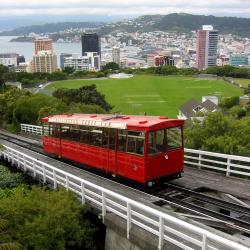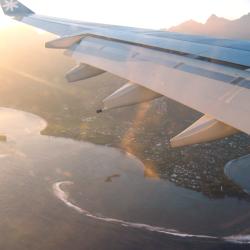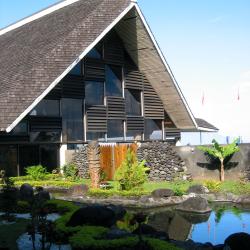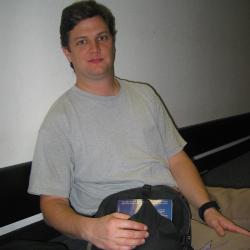One fun and cool thing we did on our recent New Zealand trip was take along a hand-held GPS device, loaned to us by our wonderful friend Frank Campagna, so that we could mark locations we visited. The GPS came in very handy when driving, as well, as we did have any other New Zealand maps with us, other than those in the guide books or tourist magazines we picked up along the way.
 Frank’s GPS is an eTrex Legend, which is a good, solid, basic GPS available from Garmin. The device has US maps burned into it, but you can also buy additional maps and load them on the device so that it gives you more than the basic longitude/latitude/altitude info when you leave the US. I picked up a copy of the Garmin WorldMap CD on eBay for about $50, which I loaded on to the eTrex. These maps did not give the detail of the US street level mapping, but it was enough to help us get around cities and get between towns. Overall, the system worked really, really well and made the trip much more enjoyable.
Frank’s GPS is an eTrex Legend, which is a good, solid, basic GPS available from Garmin. The device has US maps burned into it, but you can also buy additional maps and load them on the device so that it gives you more than the basic longitude/latitude/altitude info when you leave the US. I picked up a copy of the Garmin WorldMap CD on eBay for about $50, which I loaded on to the eTrex. These maps did not give the detail of the US street level mapping, but it was enough to help us get around cities and get between towns. Overall, the system worked really, really well and made the trip much more enjoyable.
Along the way, we saved particular long/lat points on the GPS that we wanted to look up later. Using Google Earth, it is actually pretty easy to find a lot of the locations of the highlights of the trip. However, using the GPS, I’m able to find some locations that are not really clear on Google Earth, given the current low-resolution of most of their New Zealand image data.
 First, a word about Google Earth. Chances are, if you are reading this, I’ve probably had a chance to tell you in person how much I love Google Earth, especially as a fun, basic, fast GIS tool. If you don’t already have it installed on your computer (and your computer is less than 3 years old), go to the Google Earth website, download it, and install it. They have versions for Windows and Mac OS, so there’s really no excuse for not using this wonderful free tool.
First, a word about Google Earth. Chances are, if you are reading this, I’ve probably had a chance to tell you in person how much I love Google Earth, especially as a fun, basic, fast GIS tool. If you don’t already have it installed on your computer (and your computer is less than 3 years old), go to the Google Earth website, download it, and install it. They have versions for Windows and Mac OS, so there’s really no excuse for not using this wonderful free tool.
Once you have Google Earth installed, there are quite a few things that you can do with it. One of my favorite is saving a location to file (Google Earth calls them KMZ files) that you can email to someone or post on a web page, and someone else can open it up and Google Earth will take them to that location. You can also chain locations together in a KMZ file to create a virtual flying tour from place to place within the Google Earth interface.
Below, I’ve posted links to a few KMZ files that will take you to locations where I took photos in New Zealand. Using Google Earth, you can see the view from space of the place where I took the photo. Previously, you could show someone on a map where you were when you took a particular photo, but now, using Google Earth, you can give them a different perspective on the same landscape in the photograph.
Note: You have to have Google Earth installed on your computer and have your web browser configured to pass KMZ files to Google Earth in order for these links to work for you.
 Jaymie’s Tree in Blenheim – This is the tree that Jaymie picked out before we went on the trip and that we visited when we got to Blenheim.
Jaymie’s Tree in Blenheim – This is the tree that Jaymie picked out before we went on the trip and that we visited when we got to Blenheim.
 Interislander Ferry Moving Through Marlborough Sounds – This location came froma GPS coordinate (S 41 14 30.6, E 174 03 28.2) pulled off of the eTrex. Right after I took this coordinate with the eTrex, I shot these photos of Picton as we pulled into port.
Interislander Ferry Moving Through Marlborough Sounds – This location came froma GPS coordinate (S 41 14 30.6, E 174 03 28.2) pulled off of the eTrex. Right after I took this coordinate with the eTrex, I shot these photos of Picton as we pulled into port.
 Kaikoura Panographic Photo – This is the location where I took a panographic photo I hope to post soon. In the meantime, these are more basic photos of the same area.
Kaikoura Panographic Photo – This is the location where I took a panographic photo I hope to post soon. In the meantime, these are more basic photos of the same area.
 Te Pukatea, Abel Tasman National Park – This is the beach Kath and I hiked to on the Abel Tasman coastal trail.
Te Pukatea, Abel Tasman National Park – This is the beach Kath and I hiked to on the Abel Tasman coastal trail.
 City of Westport, Western South Island, New Zealand – This is the mouth of the river, near the hostel where we stayed.
City of Westport, Western South Island, New Zealand – This is the mouth of the river, near the hostel where we stayed.
I’ll post some more of these, eventually, if it turns out anyone enjoys them. Leave a comment if you want me to post more.

 We spent our first day simply wandering around and catching some of the better museums. I can recommend to anyone that the first thing you should do in Wellington, so long as it is daytime, is to take the cable car to the top of hill that overlooks the city and then wander through the botanic gardens as you walk downhill back to the city. The part about downhill is very important. Downtown Wellington is shaped like a roughly-shaped bowl, open on the side that faces the harbor. As long as you stay near the water, you will not have to climb too many hills. However, leave the main downtown area and you will really give your legs (and lungs and heart) a work-out. After a couple of days, Kath and I have learned to ask questions of ourselves when planning a particular trek, such as: “How far up will this take us?” or “Is there a similar store that is not over that steep ridge?”
We spent our first day simply wandering around and catching some of the better museums. I can recommend to anyone that the first thing you should do in Wellington, so long as it is daytime, is to take the cable car to the top of hill that overlooks the city and then wander through the botanic gardens as you walk downhill back to the city. The part about downhill is very important. Downtown Wellington is shaped like a roughly-shaped bowl, open on the side that faces the harbor. As long as you stay near the water, you will not have to climb too many hills. However, leave the main downtown area and you will really give your legs (and lungs and heart) a work-out. After a couple of days, Kath and I have learned to ask questions of ourselves when planning a particular trek, such as: “How far up will this take us?” or “Is there a similar store that is not over that steep ridge?” The museum that really got me excited about coming to Wellington was Te Papa, the new national museum opened only a few years ago. And, I can say that the museum really doesn’t disappoint, expecially since I mostly wanted to see exhibits concerning the experiences of the Maori people (the native inhabitants of New Zealand). I read several books regarding the inital impact of European culture on Maoris, and since most cultural sites revolving around Maori culture are located in the North Island, in places we weren’t going, I was keen to see what I could, especially if I could glimpse it in the mind’s eye of the “average” New Zealand citizen (or even want they wanted to project to the world). Te Papa does a great job of not only bringing Maori history and culture alive but also showcasing current and relevant Maori struggles in the perspective of the various participants, Maori and non-Maori alike. Te Papa is not scared to address issues that are not really settled yet and are still heavily contended. I learned a lot from the museum that I would have never picked up from books, and I guess that might as well be the definition of an important museum.
The museum that really got me excited about coming to Wellington was Te Papa, the new national museum opened only a few years ago. And, I can say that the museum really doesn’t disappoint, expecially since I mostly wanted to see exhibits concerning the experiences of the Maori people (the native inhabitants of New Zealand). I read several books regarding the inital impact of European culture on Maoris, and since most cultural sites revolving around Maori culture are located in the North Island, in places we weren’t going, I was keen to see what I could, especially if I could glimpse it in the mind’s eye of the “average” New Zealand citizen (or even want they wanted to project to the world). Te Papa does a great job of not only bringing Maori history and culture alive but also showcasing current and relevant Maori struggles in the perspective of the various participants, Maori and non-Maori alike. Te Papa is not scared to address issues that are not really settled yet and are still heavily contended. I learned a lot from the museum that I would have never picked up from books, and I guess that might as well be the definition of an important museum. We made it to Wellington without incident, connecting through Tahiti and Auckland, as planned. Up to now, we had always flown across the Pacific in a complete leap, starting from Los Angeles or San Francisco and landing in Sydney or Auckland. In order to get the cheap seats to make this trip possible, we had to fly Air Tahiti Nui, the national airline of Tahiti, which stops for a few hours in Papeete, the capital of Tahiti, on the way to Auckland.
We made it to Wellington without incident, connecting through Tahiti and Auckland, as planned. Up to now, we had always flown across the Pacific in a complete leap, starting from Los Angeles or San Francisco and landing in Sydney or Auckland. In order to get the cheap seats to make this trip possible, we had to fly Air Tahiti Nui, the national airline of Tahiti, which stops for a few hours in Papeete, the capital of Tahiti, on the way to Auckland.


 We arrived in Los Angeles from Little Rock via Houston with little incident. The Air Tahiti Nui flight boards in less than 1 1/2 hours, and the prospect of setting on plane for 8 hours, waiting, 3 hours, and then flying 6 hours more, only to sit in Auckland for 3 hours before flying on to Wellington, is, well, a little daunting. Though I’ve made flights of this duration quite a few times, I’m still a little amazed that it is possible to travel so far, so fast. I guess I should just find my seat, grab a drink, and reflect on how strange it is to be a 33,000 feet … while I’m at 33,000 feet.
We arrived in Los Angeles from Little Rock via Houston with little incident. The Air Tahiti Nui flight boards in less than 1 1/2 hours, and the prospect of setting on plane for 8 hours, waiting, 3 hours, and then flying 6 hours more, only to sit in Auckland for 3 hours before flying on to Wellington, is, well, a little daunting. Though I’ve made flights of this duration quite a few times, I’m still a little amazed that it is possible to travel so far, so fast. I guess I should just find my seat, grab a drink, and reflect on how strange it is to be a 33,000 feet … while I’m at 33,000 feet. The conference was more stimulating and interesting than I expected, and I was honored to be able to share the stage with University of Virginia’s
The conference was more stimulating and interesting than I expected, and I was honored to be able to share the stage with University of Virginia’s 
 2) What is the name of the holiday being celebrated during the parade scene near the end of
2) What is the name of the holiday being celebrated during the parade scene near the end of 





 The first 1/3rd of the trip takes place in a hardwood forest, with a somewhat narrow river channel and a clearly defined river bank. There are plenty of obstacles, above and below the water, and you have to stay sharp in the rather shallow water so as to not take a wrong turn and have to back-track. This is a very smooth part of the river, quiet and majestic, with towering, moss-ringed trees on both sides as you glide by.
The first 1/3rd of the trip takes place in a hardwood forest, with a somewhat narrow river channel and a clearly defined river bank. There are plenty of obstacles, above and below the water, and you have to stay sharp in the rather shallow water so as to not take a wrong turn and have to back-track. This is a very smooth part of the river, quiet and majestic, with towering, moss-ringed trees on both sides as you glide by. Eventually you reach the beginning of the section that gives the Ghost River its name, a shallow, broad section that flows through a hardwood forest, filled with giant trees and knobs, sometimes with only a few feet between them. Even for a narrow kayak on the approved canoe trail, squeezing through some of the trees proved to be a real problem, especially given the fact that current often runs against the direction of the trail. The canopy above masks the light, and even in the middle of the day, everything gets just a little more spooky. The edges of the bank are usually still in sight but much further away, not that you have time to contemplate how you would get to the bank in your constant struggle to stay on the water path. Think swamp with moving water.
Eventually you reach the beginning of the section that gives the Ghost River its name, a shallow, broad section that flows through a hardwood forest, filled with giant trees and knobs, sometimes with only a few feet between them. Even for a narrow kayak on the approved canoe trail, squeezing through some of the trees proved to be a real problem, especially given the fact that current often runs against the direction of the trail. The canopy above masks the light, and even in the middle of the day, everything gets just a little more spooky. The edges of the bank are usually still in sight but much further away, not that you have time to contemplate how you would get to the bank in your constant struggle to stay on the water path. Think swamp with moving water. Eventually, the Ghost River Canoe Trail opens up to what is referred to as Spirit Lake, a broad section of the river with fewer trees, a slightly calmer current, lily pads everywhere on the edges of the channel, and more light. The river meanders through the more open forest, allowing a break from the constant struggle to steer experienced in the Ghost River section. In the Fall, this is the section with the most leaf color and other beautiful scenes. You can see beaver dams off in the backwater areas, large birdhouses built for birds of prey, and stands of thicker forest in the distance. The trees all around you remind you of how high the water can rise, with dark moss rings circling all of the trunks at same height.
Eventually, the Ghost River Canoe Trail opens up to what is referred to as Spirit Lake, a broad section of the river with fewer trees, a slightly calmer current, lily pads everywhere on the edges of the channel, and more light. The river meanders through the more open forest, allowing a break from the constant struggle to steer experienced in the Ghost River section. In the Fall, this is the section with the most leaf color and other beautiful scenes. You can see beaver dams off in the backwater areas, large birdhouses built for birds of prey, and stands of thicker forest in the distance. The trees all around you remind you of how high the water can rise, with dark moss rings circling all of the trunks at same height. The final section before taking out at Bateman’s Bridge resembles an alpine mountain stream. The banks draw in closer together, the river grows deeper, and the current increases quite a bit. Grassy banks leap from the edges of the river, and meadows appear on either side. If you didn’t know that you were on the Wolf River, you might think you were in Colorado in the middle of summer.
The final section before taking out at Bateman’s Bridge resembles an alpine mountain stream. The banks draw in closer together, the river grows deeper, and the current increases quite a bit. Grassy banks leap from the edges of the river, and meadows appear on either side. If you didn’t know that you were on the Wolf River, you might think you were in Colorado in the middle of summer.